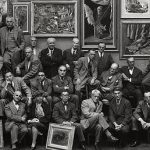
The Smithsonian Libraries is pleased to announce the donation of research ephemera for more than 4,000 artists from the Art Students League of New York (ASL), to be housed at the American Art Museum and Portrait Gallery (AA/PG) Library.

The Smithsonian Libraries is pleased to announce the donation of research ephemera for more than 4,000 artists from the Art Students League of New York (ASL), to be housed at the American Art Museum and Portrait Gallery (AA/PG) Library.
The blog post was written by Xavier Courouble for the Warren M. Robbins Library, National Museum of African Art, Smithsonian Institution, on the occasion of the 75th anniversary of Léopold more »
This post was written by Brittney Falter, a graduate student at George Mason University and social media intern at the Smithsonian Libraries. Paul Laurence Dunbar was born in Dayton, Ohio more »
Imagine yourself in the late 19th Century. Maybe you just sat down to watch a game of croquet on your lawn while chatting with some friends. This trade catalog from 1875 includes an item that might have been useful for that very thing.
At the beginning of February, Black History Month, the former slave Frederick Douglass (1818-1895) was much in the news. The most prominent African American of the 19th century, he first moved to Washington, D.C. in the early 1870s after his home in Rochester, New York burned down. Here he published his newspaper, The New National Era. From 1877 until his death in 1895, Douglass lived and worked in a stately Victorian house, called Cedar Hill, overlooking the Anacostia River. The property is in the D.C. Southeast quadrant and has been maintained since 1988 as a National Historic Site by the National Park Service.
Last year, the Dibner Library for the History of Science and Technology received four unique donations by siblings James L. Cerruti and Vera V. Magruder (nee Cerruti): James Bishop’s musical Gamut of 1766, Uri Bishop’s Military Music from the War of 1812, and Jonathan Edwards’ Treatise on Religious Affections (New York: American Tract Society) and Sermons on Various Important Subjects (Edinburgh/Boston: Gray, 1785). These items provide fascinating glimpses into early American history as well as their own family tale.
In the early eighteenth century, English naturalist Mark Catesby set foot in a New World. After spending the better part of ten years, spread across two separate trips, exploring and more »